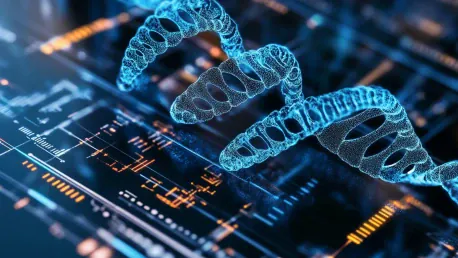The rapid development of Evo 2, the most advanced AI model yet created by the Arc Institute, represents a remarkable leap forward in genomic science. This groundbreaking technology has the ability to read and write DNA sequences, offering far-reaching implications for both biology and medicine. Evo 2 marks a milestone in the burgeoning field of generative biology, where artificial intelligence isn’t just about decoding genetic information but also creating novel DNA sequences that were previously unimaginable.
The Role of AI in Modern Biology
Evo 2 captures the essence of transitioning from manual DNA decoding to employing sophisticated AI for comprehensive genetic analysis and sequence generation. This paradigm shift not only streamlines the interpretation of genetic data but also enhances the accuracy of these endeavors, paving the way for new and more effective biological discoveries.
At the core of Evo 2 is a specially designed transformer architecture, aptly named “Striped Hyena 2.” Unlike its predecessors, this architecture can process an astonishing 1 million DNA bases simultaneously, vastly outstripping earlier models’ capabilities, including those found in Evo 1. This enhanced processing power significantly reduces the time and resources needed for DNA analysis and sequence generation, making it a game-changer in the field.
Implications for Healthcare
Evo 2’s potential for revolutionizing healthcare lies in its unmatched ability to identify genetic patterns linked to various diseases. By accurately analyzing these patterns, researchers can design treatments that are significantly more targeted and personalized, ushering in the era of precision medicine.
One of Evo 2’s most promising applications is in predicting the impact of genetic variants, particularly those associated with serious conditions such as breast cancer. For example, the AI’s capability to analyze the BRCA1 gene, which is closely linked to breast cancer, goes beyond merely identifying mutations. It can predict the potential impact of both known and previously unexplored genetic variants, offering a much clearer path for assessing disease risks. This predictive power is a critical asset for developing personalized treatment strategies that could potentially save countless lives.
Advancements in AI Models
The journey from Evo 1 to Evo 2 epitomizes the continuous improvement inherent in AI models. Evo 2 is not just a refinement but a complete overhaul built on the lessons learned from its predecessor. The remarkable advances in machine learning and data processing capabilities are evident in Evo 2’s performance and functionality.
The model’s training process involved an extensive dataset consisting of 9.3 trillion DNA letters extracted from nearly 130,000 different species. This vast and diverse dataset forms the foundation for its deep learning capabilities, enabling Evo 2 to excel in analyzing both coding and noncoding regions of the genome. The intricacy of its training sets it apart from earlier versions, allowing for unprecedented accuracy and depth in genetic analysis.
Understanding Noncoding DNA
One of the most significant challenges that genomics has faced is the interpretation of noncoding regions of the human genome, which constitute approximately 98% of our total genetic sequence. Historically, these regions have been somewhat of a black hole, difficult to interpret and analyze. However, Evo 2 stands out for its exceptional prowess in deciphering these previously obscure areas.
The ability to interpret noncoding DNA is crucial for gaining a comprehensive understanding of the human genome and its various roles in health and disease. Evo 2’s capabilities in this domain mean that researchers can now explore parts of the genome that were previously inaccessible, potentially unlocking new insights into disease mechanisms and biological functions.
Predictive Power and Practical Applications
Evo 2’s predictive power is best showcased in its ability to analyze genetic variants accurately. By predicting the potential impact of these variants—whether they’re well-known or shrouded in mystery—the model provides an invaluable tool for understanding disease risk and evolution. This predictive ability is crucial for genetics research, where understanding how variations influence gene function is a fundamental objective.
Moreover, the practical applications of Evo 2 extend well beyond analysis. The model’s capability to design brand-new DNA sequences introduces revolutionary possibilities in synthetic biology and genetic engineering. Imagine the creation of genomes with properties tailored specifically for medical treatments, environmental solutions, or scientific research. Evo 2 makes these cutting-edge ideas not just possible but practically attainable.
Collaboration and Development
The creation of Evo 2 was a collaborative triumph involving the Arc Institute and leading academic institutions such as Stanford University, UC Berkeley, UCSF, and Nvidia. This interdisciplinary effort underscores the importance of combining expertise from various fields to push the boundaries of what’s possible in AI and genomics.
Furthermore, Evo 2’s architecture, base model, and user interface are publicly available on platforms like GitHub and BioNeMo. This openness fosters a collaborative environment that encourages further innovation and advancement in the field. By making their tools accessible, the creators of Evo 2 aim to democratize science, allowing researchers and innovators from around the world to contribute to and benefit from these advancements.
Future Trends in Genomics
In embodying the fusion of AI and biology, Evo 2 showcases the adaptability and transformative potential of AI across different fields. This trend points towards a future where genomics is driven by AI, providing data-driven insights that enable personalized health assessments and increasingly effective treatments.
Evo 2’s dual role in both predicting the impact of mutations and generating new genetic sequences stands as a testament to the evolving landscape of genomics. This adaptability ensures that AI will play an increasingly central role in understanding and manipulating the biological code of life, offering new tools and approaches for tackling some of the most challenging questions in biology.
Real-World Demonstrations
A notable demonstration of Evo 2’s generative power is its role in producing a functional new CRISPR-Cas system. This real-world application highlights the tangible benefits of the model’s capabilities, illustrating that the implications of Evo 2 stretch far beyond theoretical possibilities into practical and impactful outcomes.
This practical success underscores the immense potential of Evo 2 to revolutionize not just the study of genomics but also the application of genetic science in real-world scenarios. From synthetic biology to precision medicine, the advancements achieved through Evo 2 promise to offer researchers and clinicians powerful new tools for exploration and intervention.
Towards a New Era in Genomics
The achievements of Evo 2 signify a monumental step forward in the application of AI to the field of biology. As researchers continue to build upon the foundation laid by Evo 2, the potential applications of this technology are bound to expand into new and groundbreaking realms of synthetic biology and personalized medicine.
The narrative of advancement from Evo 1 to Evo 2 strongly suggests a future where even more sophisticated models will encompass the entire human genome with unparalleled precision. This predictive trajectory hints at a time when the full complexity of the human genome can be decoded, understood, and manipulated with extraordinary accuracy.
The Evolution of AI in Genomics
The rapid progress of Evo 2, the latest and most sophisticated AI model developed by the Arc Institute, signifies an extraordinary advancement in genomic science. This state-of-the-art technology goes beyond the capabilities of previous models, with an impressive ability to both read and write DNA sequences. The implications for biology and medicine are profound, as this breakthrough opens up new possibilities for understanding and manipulating the genetic code.
Evo 2 is a significant milestone in the expanding field known as generative biology. In this field, artificial intelligence doesn’t just play the role of deciphering genetic information; it also has the capability to create entirely new DNA sequences that were unimaginable before. This innovative approach marks a shift from merely studying genetics to actively designing and generating novel genetic material. By doing so, Evo 2 offers the potential to revolutionize how we approach everything from genetic research to the development of new medical treatments.
In essence, Evo 2 represents not just an evolutionary step, but a major leap forward in the realm of genomics. Through its ability to read and draft genetic codes, it presents promising opportunities for advancements in personalized medicine, genetic engineering, and beyond. As such, the influence of Evo 2 on science, medicine, and even everyday life might be revolutionary, paving the way for unprecedented innovations in the understanding and application of genomic sciences.









